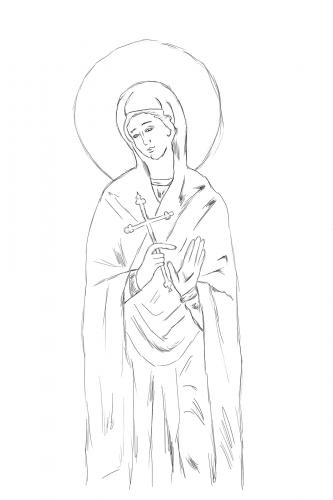



Saint Barbara
St. Barbara, or Varvara as she is known in the East, is one of the Great Martyrs of the Christianity. According to the hagiographic legend, Barbara lived during the reign of the Emperor Diocletian, famous for his anti-Christian persecutions. She was secluded into a tower by her father and there she adopts Christianity proclaiming her faith by ordering a third window to be opened into the tower wall as a symbol of Trinity. For her faith she was imprisoned, tortured and ordered by her father to be decapitated. During the Middle Ages and especially in catholic countries her legend was enriched by tales of the miracles she had performed on behalf of the believers.
Being considered one of the intercessor saints, a protector of miners, builders and architects, St. Barbara is frequently represented. Although there are no iconographic recommendations regarding a specific canon, she is shown frontally, either full-length or half-length, dressed in a long tunic and a cloak with a hood covering her hair. In Byzantine and Post-Byzantine art, St. Barbara is holding in her right hand a cross, as symbol of faith, or a palm branch, rarely a crown, both as symbols of martyrdom. Under the influence of Western art, especially from German lands, besides the Saint may be present a tower or a Eucharistic chalice, as Barbara is also the patron of the moribunds. Another Western influence may be considered the tendency to represent St. Barbara dressed in sumptuous vestments indicating her social status.
St. Barbara, or Varvara as she is known in the East, is one of the Great Martyrs of the Christianity. According to the hagiographic legend, Barbara lived during the reign of the Emperor Diocletian, famous for his anti-Christian persecutions. She was secluded into a tower by her father and there she adopts Christianity proclaiming her faith by ordering a third window to be opened into the tower wall as a symbol of Trinity. For her faith she was imprisoned, tortured and ordered by her father to be decapitated. During the Middle Ages and especially in catholic countries her legend was enriched by tales of the miracles she had performed on behalf of the believers.
Being considered one of the intercessor saints, a protector of miners, builders and architects, St. Barbara is frequently represented. Although there are no iconographic recommendations regarding a specific canon, she is shown frontally, either full-length or half-length, dressed in a long tunic and a cloak with a hood covering her hair. In Byzantine and Post-Byzantine art, St. Barbara is holding in her right hand a cross, as symbol of faith, or a palm branch, rarely a crown, both as symbols of martyrdom. Under the influence of Western art, especially from German lands, besides the Saint may be present a tower or a Eucharistic chalice, as Barbara is also the patron of the moribunds. Another Western influence may be considered the tendency to represent St. Barbara dressed in sumptuous vestments indicating her social status.




